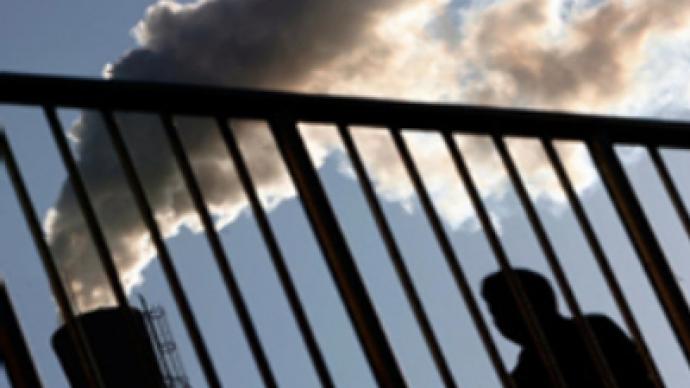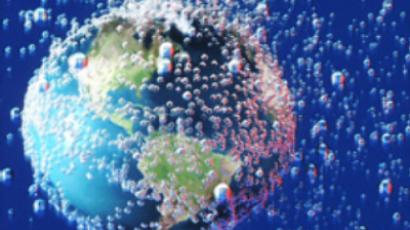Could the financial crisis save the environment?

The global economic downturn is causing financial mayhem for most people on the planet – but scientists say it could have an upside for the environment. It’s believed it could trigger more careful use of energy and help to limit carbon emission
According to the UN Intergovernmental Panel on Climate Change (IPCC) the average temperatures in certain parts of the planet (most notably – Alaska and the Siberian Republic of Yakutia) have risen by as much as 3.5º Celsius in the course of the last 38 years.
IPCC estimates suggest that the average world temperature increase may reach 4.0º Celsius by the end of the 21st century, creating a serious hazard for the world’s inhabitants.
Four degrees of dioxide disaster
According to a strategic framework, published by the environment department of the World Bank, “as little as a 1º C rise in temperature is estimated to result in a 5 to 10% yield reduction of major cereal crops in low latitude regions”.
The IPCC has an even graver prediction:
– a 1.5º Celsius rise of the average Earth temperature would see major damage to polar ecosystems
– 2.5º – the loss of the Amazon rainforests along with their inhabitants, as well a high risk of extinction of polar bear
– 3.5º – a predicted extinction of corals and up to 40% of endemic species of the planet
– 4.0º – an inability of 50% of nature's reserves to fulfill their biological objectives.
The potential impact of the climate change on agriculture by 2080, projected by the World Bank’s environmentalists, is also nothing short of disastrous. Most of the near-equatorial regions – major parts of Latin America, all of Africa, the Middle East and India – will suffer a 5-25% decrease in agricultural productivity, for which a 5-15% increase of productivity in Russia, Canada and Europe will hardly be able to compensate.
The temperature increase also has a direct impact on human life. With a 10º Celsius increase of mean daily temperature in August of 2003 compared to 1999-2002, the mean mortality increases sixfold (300 instead of 50).
The main cause of the temperature increase – a.k.a. the Greenhouse Effect – is the carbon dioxide (CO2 or the greenhouse gas) which absorbs thermal infrared radiation emanated by the Earth, thus preventing it from going into space.
Largest source of trouble hit the hardest
Being the most common product of hydrocarbons’ disintegration, carbon dioxide is unavoidably created whenever fossil energy carriers are used. As the latter are the essential majority of energy carriers used by humanity (85%, according to the Energy Information Administration, EIA), some 21.3 billion tonnes of carbon dioxide are injected into the atmosphere.
Moreover the amount of carbon dioxide produced grows at a rate of almost 3% each year, despite the fact that the G8 leaders agreed to cut the world’s greenhouse gas emissions in half by 2050. At the July summit in Hokkaido, Japan, they expressed a readiness to spend some $U.S. 45 trillion on the goal.
The G8 countries have a lot to do as seven of them are in the top ten of greenhouse gas emitters. EIA figures show the U.S. and China as undisputed leaders, emitting 5,957 and 5,323 million tonnes of CO2 a year respectively. Russia is a distant third, with 1,696 million tonnes, followed by Japan (1,230) and India (1,166).
When the crisis erupted, the U.S. economy was hit the hardest, which might lead to a significant reduction of its carbon dioxide emissions, due the abnormal consumer influence on the structure of U.S. emissions.
Consultants McKinsey & Co recently published a report claiming that U.S. consumers have direct or indirect control over 65% of the country's greenhouse-gas emissions. A similar figure for the rest of the world is just 43%.
Passenger cars provide 17% of U.S. emissions (which makes some 1,012 millions tonnes, more then whole of Germany), with a similar figure for residential buildings and appliances. Air and sea transportation account for some 3%, as do landfill emissions.
With the market crisis making saving money an imperative, these figures could easily be lowered, even without major government efforts like ratifying the Kyoto protocol.
The U.S. and Australia are the only large polluters who didn’t agree to the objective of making emissions less then their 1990 level. For its part, Russia’s current emissions stand at just 77% of the 1990 figure.
Nobel winner sees advantages of crisis
Atmospheric scientist Paul J Crutzen – winner of the 1995 Nobel Prize in Chemistry for his work on the depletion of the ozone layer – believes that slower economic growth worldwide could help to cut the growth of carbon dioxide emissions.
“It's a cruel thing to say,” he said, “but if we are looking at a slowdown in the economy, there will be less fossil fuels burning, so for the climate it could be an advantage. We could have a much slower increase of CO2 emissions in the atmosphere, people will start saving (on energy use). But things may get worse if there is less money available for research and that would be serious.”
Crutzen is also well-known for his 2006 suggestion to bombard the stratosphere with sulphur to get rid of the greenhouse effect.
His calculations claim that dispersing a million tonnes of sulphur 10 miles above the earth would deflect sunlight, and thereby cool the planet. The theory – largely considered speculative, unproven and with risky side-effects – is based on the observation that average world temperature dropped by 0.5 degrees centigrade after the Pinatubo volcano erupted in the Philippines in 1991. It would cost an estimated $10-20 million.
A similar idea – shooting sunlight-scattering particles into the stratosphere – was expressed by Russian climate scientist Mikhail Budyko in the 1970s.
Ruben Zarbabyan, RT
Related links
Green alarm for Russia’s economic boom













